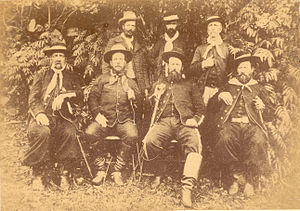Federalist Riograndense Revolution (Brazil)
| Brazilian Federalist Revolution | |||||||
|---|---|---|---|---|---|---|---|
| Part of Brazilian Naval Revolt | |||||||
 Gumercindo Saraiva and their commanders. |
|||||||
|
|||||||
| Belligerents | |||||||
|
|
|
||||||
| Commanders and leaders | |||||||
|
|
|
||||||
| Strength | |||||||
| 22,000 soldiers and militia | 7,500 federalist rebels ~500 rebel sailors |
||||||
| Casualties and losses | |||||||
| 10,000 killed | |||||||
The Federalist Riograndense Revolution (1893 - 1895) was a revolution in the State of Rio Grande do Sul in Brazil against the recently-formed Republic, proclaimed in 1889.
Inspired by the monarchist ideologies from Gaspar da Silveira Martins, it had Gumercindo Saraiva as the military head. The revolutionaries, known as Maragatos, faced defeat in the Battle of the Pulador, in 1894, by the troops of Pinheiro Machado, but peace was only concluded definitively on the following year.
At the time, then President Marshal Floriano Peixoto summoned veteran of the Paraguayan War Colonel Gomes Carneiro. His orders were to halt the Federalist Revolution in Southern Brazil. In five days, he came to the area to replace General Argolo. It was November 1893 and the revolutionary troops were now advancing towards the state of Paraná.
The goal was to reach the Brazilian capital at the time, Rio de Janeiro, and overthrow the government of Floriano. The rebels also fought against the governor of Rio Grande do Sul, Júlio de Castillos. With the revolution, the three southern states became the scene of a bloodbath that left nearly 10,000 dead. During and after the battles, there were many degolas.
In the capital, the Revolt of the Navy began, under the leadership of Admiral Custódio de Melo, who also fought against Floriano. After some exchange of gunfire with the army, the rebels went to the South. After docking in the city now known as Florianópolis, called Desterro at the time, they proclaimed the city as a new capital. Interests meant that the two revolts came to join.
"They have joined forces to overthrow Floriano. By sea, Custódio de Melo was responsible for striking Paranaguá, which happened in January 1894" says the judge and scholar Paul Hapner. By land, Gumercindo Saraiva advanced towards the state capital.
In the same period that the coast was taken, the Maragatos passed by Tijucas do Sul and came to Lapa - only 60 km away from Curitiba, capital of the state of Paraná.
...
Wikipedia
